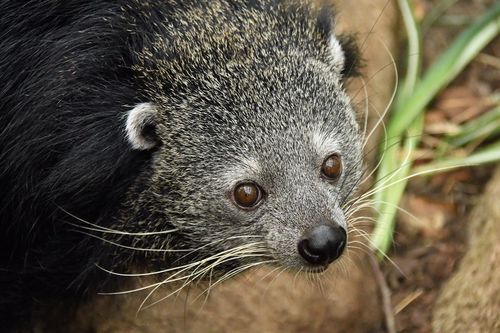
Binturong
The binturong (Arctictis binturong) enchants with its bear-like appearance and cat-like agility. This nocturnal creature thrives in Southeast Asian rainforests, using its prehensile tail to navigate treetops. Notably, it smells like popcorn, aiding in seed dispersal while enriching the forest's biodiversity.
10-25 years
Lifespan
45579.0 kg
Weight
Length: 60 - 96 cm
Size
Brown, Grey, Black
Color
2-3 years
Age of Sexual Maturity
6-8 weeks
Age of Weaning
15 mph
Top Speed
Vulnerable
Conservation Status
Decreasing
Population Trend
Characteristics
The binturong, also known as the bearcat, is native to the rainforests of Southeast Asia. It has a prehensile tail, a shaggy black coat, and a scent reminiscent of buttered popcorn. Binturongs are arboreal and primarily nocturnal, playing a crucial role in seed dispersal within their ecosystem.
Distribution Range of the Binturong
The Arctictis binturong, commonly known as the binturong or bearcat, is native to South and Southeast Asia. Its geographical distribution spans several countries including India, Nepal, Bhutan, Bangladesh, Myanmar, Thailand, Laos, Cambodia, Vietnam, Malaysia, Indonesia, and the Philippines. The species is notably found in regions such as the Western Ghats, the Eastern Himalayas, and the islands of Borneo and Sumatra.
Binturong's Habitat
Environmental Conditions
Binturongs primarily inhabit tropical and subtropical forests. They are arboreal creatures, thriving in dense forest canopies where they can navigate through trees with ease. The typical environmental conditions include high humidity and warm temperatures, consistent with the climate of tropical rainforests. These forests often have a rich diversity of flora and fauna, providing ample food sources and shelter.
Ecological Niche
Ecologically, binturongs are omnivorous and play a role as both predator and seed disperser within their habitat. They feed on a variety of foods, including fruits, small animals, and insects. Their arboreal lifestyle and prehensile tails allow them to exploit resources in the forest canopy, making them important for maintaining the ecological balance by dispersing seeds and controlling insect populations. Regional adaptations may occur, with some subspecies showing variations in diet and behavior based on local environmental conditions.
Copyright @ Nature Style Limited. All Rights Reserved.
 English
English